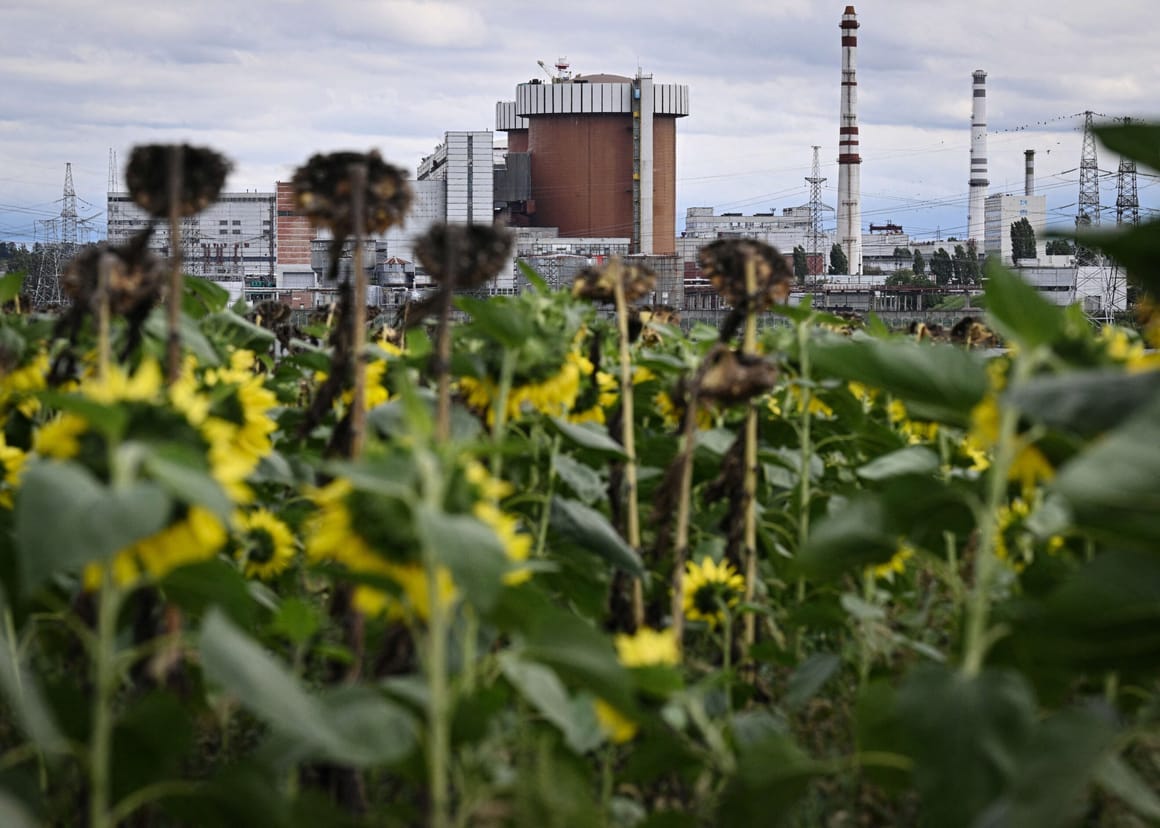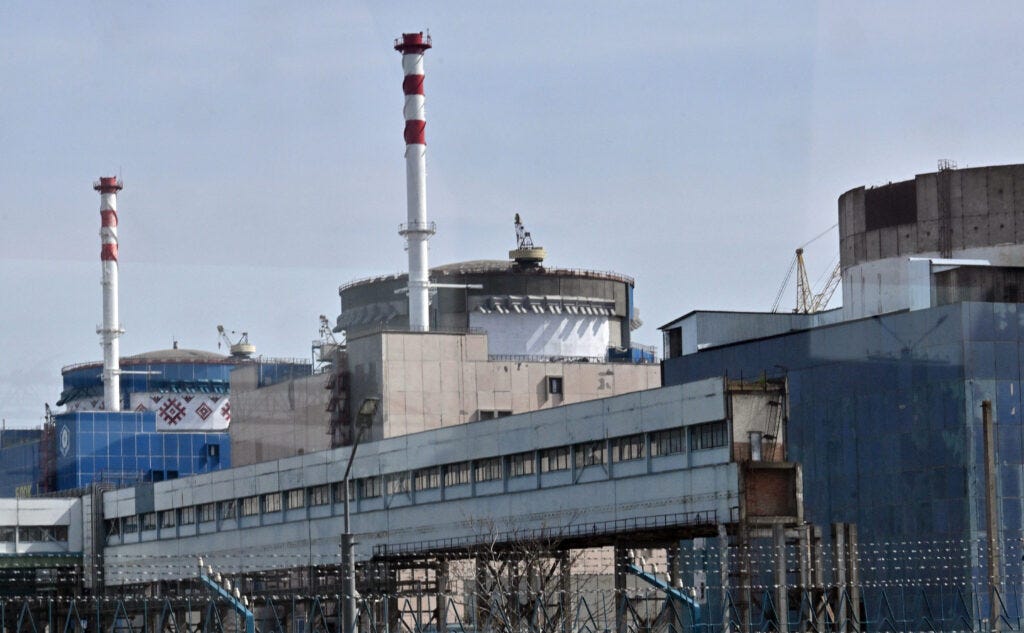LLAW’s All Things Nuclear #751, Sunday, (09/15/2024)
“End Nuclear Insanity Before Nuclear Insanity Ends Humanity”
Ukraine has three nuclear power plants that are targets of the Russia/Ukraine war.
LLAW’s NUCLEAR VIEWS, ISSUES & COMMENTS, Sunday, (09/15/2024)
As I wrote yesterday in my previous blog #750, expanding the US’s participation in the Russia/Ukraine war beyond limited and localized use of military weapons and other hardware has put the United States between a rock and a hard place. The following ‘Politico’ article helps to more clearly explain why. The overall situation is murkily scary and obviously dangerous.
But as I’ve said many times before, ‘deterrence’ alone cannot and will not avoid nuclear war forever, and the tense situation involving, in particular, the United States, Britain, Ukraine, other NATO countries, and Russia with their allies, may be moving beyond the much ballyhooed “deterrence” stage, which is based on fear of one another’s nuclear powers, including nuclear weapons of mass destruction and, now, nuclear power plants, which are obviously important participants in a real nuclear war. This situation alone, whether settled amicably or not, should convince all of us around the world that no new nuclear power plants should ever be built anywhere, and the older ones shut down and permanently dismantled and all existing nuclear arms together with all uranium fuel and radioactive nuclear waste buried deep in impenetrable ground where future access to it can never be accomplished by any nation for any reason.
Failing to do this now (and it will take many years of cooperative effort among global nations) may well mean the beginning of the end of sentient life on our wonderful planet Earth ~llaw
As Biden deliberates, Ukraine’s nuclear plants are increasingly at risk
The risk of Ukraine losing the war this winter has pushed Washington and London to reconsider how Kyiv uses Western-supplied long-range missiles, but the U.S. remains fearful of escalation.

Unpacked
September 15, 2024 2:44 pm CET
Jamie Dettmer is opinion editor at POLITICO Europe.
KYIV — As the U.S. ponders loosening some of the restrictions on Ukraine’s use of Western-supplied long-range missiles to allow for the targeting of airfields and missile launch sites deeper inside Russia, Ukraine remains on tenterhooks.
As it stands, Washington doesn’t appear ready to take the gloves off entirely and allow Ukraine to target Russia’s airfields with long-range U.S. missiles quite yet — though it may withdraw restrictions on the U.K.’s Storm Shadows, which use U.S. technology.
“I would like to see a more forthright position coming from the Biden administration that says there’s no reason why Ukraine shouldn’t be fighting back,” former U.S. envoy to NATO Kurt Volker told POLITICO. “Russia’s the one attacking Ukraine from all these facilities across Russia. There’s no reason for there to be a sanctuary. But I don’t think we’re going to see Biden authorizing the use of U.S. missiles to strike at Russian airfields, although the British might be allowed to proceed without U.S. objection,” he added. “That won’t be enough.”
And if that’s really the outcome of these weeks-long intense negotiations, Ukraine’s energy officials will be among those most alarmed.
They fear this coming winter may prove to be a breaking point for Ukraine in the energy war. And that’s largely because Russian commanders are adapting their airstrike tactics, having learned from their previous failed bombing campaign to collapse the country’s energy system — and the recent shipments of Iran’s Fath-360 close-range ballistic missiles to Russia will help them do so.
Ukrainian officials expect Russia will use these missiles, which have a range limit of 120 kilometers, to complement their glide bombs in targeting logistics and communications hubs and ammunition depots in the rear of Ukraine’s front lines. That, in turn, will free Russia up to concentrate its own longer-range missiles on civilian infrastructure — particularly the energy system in a bid to break it.
Stuck in the crosshairs are key substations feeding high voltage electricity to Ukraine’s still functioning nuclear power stations in Rivne, Khmelnytskyi and Yuzhnoukrainsk in southern Ukraine. Take these substations out and the reactors have to be shut down rapidly, or else it could provoke a “nuclear incident,” energy expert Mykhailo Gonchar told POLITICO. And “that’s what the Russians are aiming to do — hit the key substations.”
Currently, 55 percent of Ukraine’s energy is generated by its three operating nuclear power stations — the one in Zaporizhzhia, which is the largest nuclear plant in Europe, was captured by Russia in 2022 and has largely been shut down. Russian missile and drone strikes have destroyed 9 gigawatts of the country’s electrical generating capacity — that’s half of the peak winter consumption — with 80 percent of thermal generation from coal- and gas-fired power plants and a third of hydroelectric production capacity wiped out by bombing.
Last year, Russia tried to isolate these nuclear power plants, focusing on degrading Ukraine’s energy transmission. It targeted distribution to consumers and businesses but was met with characteristic Ukrainian ingenuity and confounded by improvised repairs and rerouting.
Paralyze the three nuclear power stations, though, and it’s game over for Ukraine in the energy war , diminishing its war-fighting capacity, crashing the economy and weakening its position if peace negotiations do ever commence.
And according to officials in Kyiv, it’s the fear of this happening that’s been one of the factors driving the Biden administration to reconsider the restrictions, including on U.S. ATACMS and British Storm Shadows. Washington sat up when Russian airstrikes started targeting the main substations feeding operational electricity to the nuclear power plants in late August. “That concentrated minds,” said one Ukrainian official who asked not to be identified in order to speak freely.

Based on a study by Gonchar’s Center for Global Studies that was shared with NATO, a Russian strike on Aug. 26 signaled this switch in tactics. It was massive — one of the biggest airstrikes since the start of the war almost three years ago — and made combined use of both Iranian-supplied Shahed drones and Russian-made cruise and ballistic missiles.
Russia launched 109 drones that day, in an offensive orchestrated to tie up Ukrainian air defenses, while strategic Russian bombers and MiG-31K fighters flying from airfields inside Russia launched 127 cruise and ballistic missiles targeting the nuclear power plants’ electricity-feeding substations. Ukrainian air defenses had success in intercepting them but, nonetheless, there were 32 hits causing significant damage.
“If we aren’t given the opportunity to target deeper inside Russia and reach Russian airfields, our chances [of getting] through this winter aren’t so great,” Gonchar noted grimly. And Volodymyr Kudrytskyi, the former CEO of Ukraine’s national power transmission network Ukrenegro, agrees with that assessment. Speaking to POLITICO, he said there were three factors that would prove critical for Ukraine this winter — the weather, Russian missiles and Ukraine’s ability to strike Russian airfields to interdict strategic bombers and fighters. His greatest fear is that it will turn into a repeat of late 2022, when he truly feared they wouldn’t manage to keep the lights on.
For their part, Ukrainian officials hope the prospect of the energy system’s collapse will ultimately outweigh Washington’s fears of escalation, which have so often unnerved Western allies when deciding what to supply Ukraine with, in what quantities and what Ukraine can do with what it’s given. They’ve been complaining about the West allowing Russia’s threats of retaliation to shape its policy and pursue escalation management based on fear.
Of course, Russian President Vladimir Putin predictably upped his rhetoric last week as news emerged of a possible reconsideration regarding restrictions on the use of Western-supplied long-range missiles inside Russia, saying it would put NATO “at war” with Russia and “significantly change” the nature of the Ukraine conflict. It would amount to “nothing less than the direct involvement of NATO countries,” he menaced.
Following his cue, other senior Russian officials chorused, with Deputy Minister of Defense Alexander Fomin warning that the West is playing a dangerous game, which could lead to a direct military clash between nuclear powers.
But Ukrainian officials argue that such blood-curdling nuclear threats — among the most explicit since the Cold War — are empty, and that each and every time a new weapons system has been supplied or used over the border inside Russia, or fired at targets in occupied Crimea and Donbas, they’ve come to nothing.
Meanwhile, Western officials argue they have little option but to be prudent and take the threats seriously — that they have a duty to do so because the consequences could be catastrophic if they miscalculate. And yet, last week CIA Director William Burns referenced Moscow’s nuclear threats from 2022 as an example of why such statements shouldn’t always be taken at face value: “Putin is a bully. He’s going to continue to sabre rattle . . . We cannot afford to be intimidated by that,” he said at a London conference.
Even so, Burns also stressed no one should underestimate the risk of escalation and admitted his agency genuinely feared Russia might resort to tactical nuclear weapons in 2022. And while Biden and British Prime Minister Kier Starmer brushed off Putin’s threats on Friday, the U.S. administration still appears to be trapped between two worries — fear of how Moscow might respond if Western-supplied missiles start striking Russian airfields, and wreck projects for peace talks to get going, and alarm over the prospect of Ukraine losing power.
Biden critics argue he’s being overly cautious. “Kyiv is getting hit; Kharkiv is getting hit. Ukraine should have the ability to defend itself by targeting military targets in Russia,” Donald Bacon, a U.S. congressman and former U.S. air force general told POLITICO. He expressed disappointment at emerging signs that Biden may agree to Britain’s Storm Shadows being used for attacks on Russian airfields but not American ATACMS, and he blamed the U.S. National Security Adviser Jake Sullivan for the caution.
“Time isn’t Ukraine’s friend. And so, you’ve got to give it the ability to use resources to defend itself. I think Russian escalation will be minimal because if they’re going to strike at Poland or the Baltics, I think that opens up a can of worms for Russia that it can’t afford. Who should be living in fear of who? Why are we walking in fear of Putin? Let’s let him fear us,” he added.
Volker concurs. “The president has this Cold War upbringing, a 1980s mindset that says we must avoid war at all costs. I think he’s stuck in that thinking . . . I also think that you have a team of people around him who are incredibly cautious and feel we can’t afford to be in a conflict with Russia [because] we need Russia for other issues as well,” he said.
“They think anytime the U.S. exercises power, it’s bad for the world, so we shouldn’t do it. It’s a completely wrong mindset in my view.”
ABOUT THE FOLLOWING ACCESS TO “LLAW’S ALL THINGS NUCLEAR” RELATED MEDIA”:
There are 7 categories, with the latest addition, (#7) being a Friday weekly roundup of IAEA (International Atomic Energy Agency) global nuclear news stories. Also included is a bonus non-nuclear category for news about the Yellowstone caldera and other volcanic and caldera activity around the world that play an important role in humanity’s lives. The feature categories provide articles and information about ‘all things nuclear’ for you to pick from, usually with up to 3 links with headlines concerning the most important media stories in each category, but sometimes fewer and occasionally even none (especially so with the Yellowstone Caldera). The Categories are listed below in their usual order:
All Things Nuclear
Nuclear Power
Nuclear Power Emergencies
Nuclear War
Nuclear War Threats
Yellowstone Caldera (Note: There are three Yellowstone Caldera bonus stories available in this evening’s Post.)
IAEA Weekly News (Friday’s only)
Whenever there is an underlined link to a Category media news story, if you press or click on the link provided, you no longer have to cut and paste to your web browser, since this Post’s link will take you directly to the article in your browser.
A current Digest of major nuclear media headlines with automated links is listed below by nuclear Category (in the above listed order). If a Category heading does not appear in the daily news Digest, it means there was no news reported from this Category today. Generally, the three best articles in each Category from around the nuclear world(s) are Posted. Occasionally, if a Post is important enough, it may be listed in multiple Categories.
TODAY’S NUCLEAR WORLD’S NEWS, Sunday, (09/15/2024)
All Things Nuclear
NEWS
Iran says it launched a satellite under program criticized by West over missile fears - WVTF
WVTF
All Things Considered · BBC World Service · Fresh Air · Full Disclosure · Here ... nuclear weapons. U.N. sanctions related to Iran's ballistic ...
Russian TV Host Says Putin Already Has 'Basis to Start a Nuclear War' - Newsweek
Newsweek
He added: "You say that everything is going according to plan. Pardon me, but the Nazi troops have invaded the territory of the Kursk region. This isn ...
India has a new nuclear-capable ballistic missile submarine. But can it catch up with China?
CNN
... all times. Nuclear-powered submarines are complex machines. When things break and need repairing, or just when regular maintenance is needed, the ...
Nuclear Power
NEWS
As Biden deliberates, Ukraine's nuclear plants are increasingly at risk - Politico.eu
Politico.eu
The risk of Ukraine losing the war this winter has pushed Washington and London to reconsider how Kyiv uses Western-supplied long-range missiles, ...
The mistaken conventional wisdom about nuclear energy - Pearls and Irritations
Pearls and Irritations
Are nuclear energy risks routinely, colossally overstated creating fear resulting at least in part responsible for its high cost?
Robot begins removing Fukushima nuclear plant's melted fuel - VOA News
VOA News
Nuclear fuel in the reactor cores melted after the magnitude 9.0 earthquake and tsunami in March 2011 caused the Fukushima Daiichi nuclear plant's ...
Nuclear Power Emergencies
NEWS
United States Radiation Emergency Medicine Market By Application 2024-2031 – news
meramandsaur.in
In the industrial sector, these systems are used to monitor radiation levels in nuclear power plants, manufacturing facilities dealing with ...
Nuclear War
NEWS
Alarm in UK and US over possible Iran-Russia nuclear deal | Keir Starmer - The Guardian
The Guardian
... nuclear bomb. British sources indicated that concerns were aired about ... war. Last week in London, Blinken said that US intelligence had ...
Putin Aide's Direct Nuclear War Warning To West, Cites Kursk & Long-Range Weapons ...
YouTube
In a chilling warning to the West, Putin's aide Dmitry Medvedev stated that Russia's patience with Ukraine's long-range missile strikes is wearing ...
Will Korea be swallowed up in the surging risk of nuclear war?
hani.co.kr
What distinguishes this new US nuclear strategy from the Cold War era is the shift in the primary threat from Russia to China. The strategy also ...
Nuclear War Threats
NEWS
As Biden deliberates, Ukraine's nuclear plants are increasingly at risk - Politico
Politico
But Ukrainian officials argue that such blood-curdling nuclear threats — among the most explicit since the Cold War — are empty, and that each and ...
UK foreign minister Lammy plays down Putin threats - France 24
France 24
UK foreign minister Lammy plays down Putin threats. London (AFP) – UK Foreign Secretary David Lammy accused Russian President Vladimir Putin of " ...
Putin Aide's Direct Nuclear War Warning To West, Cites Kursk & Long-Range Weapons ...
YouTube
NATO In Panic After Putin's On-Camera Threat Of Direct War? UK PM's 1st Reaction After Missile Move. Hindustan Times New 301K views · 3:48.
Yellowstone Caldera
NEWS
Earth's supervolcanoes are waking up. Here's what that means for the planet
BBC Science Focus
Yellowstone has erupted three times in the last 2.1 million years, most recently 640,000 years ago, and each time has left a caldera dwarfing that ...
Mag. 4.5 earthquake - 118 km east of Kyzyl, Respublika Tyva, Russia, on Sunday, Sep 15 ...
Volcano Discovery
List and interactive map of current and past earthquakes near Yellowstone volcano. ... Bromo is one of Indonesia's most visited volcanoes. It is the ...
Mag. 2.2 quake - 12 km S of Fern Forest, Hawaii, on Saturday, Sep 14, 2024, at 09:53 pm ...
Volcano Discovery
Yellowstone quakes · Yellowstone quakes · Latest earthquakes under Yellowstone volcano. List and interactive map of current and past earthquakes near ...





